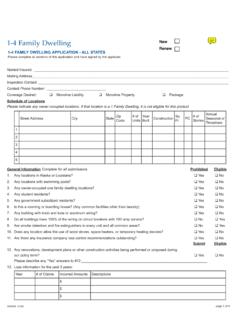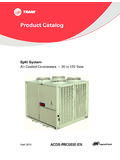Transcription of DAMP AND MOULD Health risks, prevention and …
1 DAMP AND MOULD Health risks, prevention and remedial actions information brochure Abstract This information brochure has been developed in collaboration with WHO and the Health and Environment Alliance, and was co-funded by the European Commission (DG Sanco, grant agreement 2005156). The brochure summarizes key messages that the public needs to know in order to prevent and reduce the exposure to dampness and MOULD , and to remove potential MOULD once it occurs. Emphasis is put on the problem of excessive moisture, which is the root cause for problems with dampness and MOULD in indoor built environments. Further references and user guides on actions against dampness and MOULD in several languages are provided, and reference is made to an international list of agencies providing more detailed damp and MOULD support functions to the public. This information brochure has also been produced in response to the WHO Indoor Air Quality Guidelines on Dampness and MOULD .
2 This brochure was developed following the advice of the EU Indoor Air Quality expert group, and makes available to the public some main conclusions derived in the WHO project on policy implications of actions against indoor air pollution with biological agents. Address requests about publications of the WHO Regional Office for Europe to: Publications WHO Regional Office for Europe Scherfigsvej 8 DK-2100 Copenhagen , Denmark Alternatively, complete an online request form for documentation, Health information , or for permission to quote or translate, on the Regional Office web site ( ). World Health Organization 2009 All rights reserved. The Regional Office for Europe of the World Health Organization welcomes requests for permission to reproduce or translate its publications, in part or in full. The designations employed and the presentation of the material in this publication do not imply the expression of any opinion whatsoever on the part of the World Health Organization concerning the legal status of any country, territory, city or area or of its authorities, or concerning the delimitation of its frontiers or boundaries.
3 Dotted lines on maps represent approximate border lines for which there may not yet be full agreement. The mention of specific companies or of certain manufacturers products does not imply that they are endorsed or recommended by the World Health Organization in preference to others of a similar nature that are not mentioned. Errors and omissions excepted, the names of proprietary products are distinguished by initial capital letters. All reasonable precautions have been taken by the World Health Organization to verify the information contained in this publication. However, the published material is being distributed without warranty of any kind, either express or implied. The responsibility for the interpretation and use of the material lies with the reader. In no event shall the World Health Organization be liable for damages arising from its use. The views expressed by authors, editors, or expert groups do not necessarily represent the decisions or the stated policy of the World Health Organization.
4 Acknowledgments This brochure was co-written by the Health and Environment Alliance (HEAL). HEAL aims to raise awareness of how environmental protection improves Health . Based in Brussels, it brings together 60 organisations working at the international, European and national level. Further information can be found at Scientific advice by project advisory group members (Dr Kelly, UK; Dr Kurnitski, Finland; Dr Szewzyk, Germany) during the production phase of this brochure is gratefully acknowledged. Photo credits: Braubach (page 3; 4; 6 middle and lower picture); Kurnitski (page 6 upper picture); Moriske (page 5) 3 Damp and MOULD : why you should care! In Europe, an estimated 10 50% (depending on the country) of the indoor environments where human beings live, work and play are damp. Too much moisture makes a home stuffy and gives it a faint odour. Humid walls create a coldness that makes more heating necessary and increases energy bills.
5 _____ WHO is concerned about this situation because excessive dampness and MOULD are a threat to Health . Occupants of damp or mouldy buildings are at increased risk of experiencing Health problems such as respiratory symptoms, respiratory infections, allergic rhinitis and asthma. Some people are more sensitive to MOULD than others, and some groups are especially vulnerable. Additional effort should be made to keep away from damp and MOULD babies and children, elderly people, those with existing skin problems, such as eczema, or respiratory problems, such as allergies and asthma, and anyone who is immuno-compromised ( , chemotherapy patients). On the other hand, WHO has demonstrated that remedial action works. For example, research shows that people living in well-insulated and adequately ventilated accommodation are less likely to visit their doctor or be admitted to hospital due to respiratory conditions than those living in damp homes.
6 This brochure provides practical tips for the public on how to tackle the core problem of excessive moisture (which can take the form of damp air, condensation on surfaces and increased humidity levels in materials) and how to prevent MOULD growth, as well as on how to clean up MOULD safely. Practical tips on getting rid of damp and MOULD Key message: Measures to prevent or reduce moisture are the main way to limit the development of MOULD (and any microbial) growth: Without water no MOULD ! _____ The three main actions are: 1. Detecting and locating the source of the moisture problem; 2. Removing the MOULD ; and 3. Taking action to control excessive moisture and condensation. This brochure begins with an introduction to measures to detect and locate a MOULD problem, and then provides advice on the adequate measures to take if you are to tackle the MOULD damage yourself (do-it-yourself work). The important final section informs you about appropriate measures to prevent or reduce excessive moisture.
7 It assesses causes of moisture, defines condensation and what to do to prevent it, and outlines what to do if problems persist. If you have concerns about a Health problem that may be related to humidity in your home, always contact your general practitioner. 4 1. Detecting and locating the source of the moisture problem Key message: moulds only grow when there is sufficient moisture. When MOULD appears, the first task is to try to establish where the moisture is coming from. _____ If your home is damp and possibly mouldy, you need to find out why. The question to answer, therefore, is: What is causing the moisture? Major causes for excessive moisture are: 6 Leaking pipes, wastes or overflows; 6 Rain seeping through the roof where a tile or slate is missing, spilling from a blocked gutter, penetrating around window frames, or leaking through a cracked pipe; and 6 Rising damp due to a defective damp-course or because there is no damp-course. These causes of damp often leave a "tidemark" and you should have the necessary repairs carried out to remove the source of damp.
8 If your house is newly-built it may be damp because the water used during its construction ( , plaster) is still drying out. If your home is damp for any of these reasons, it may take weeks of heating and ventilating (see section below: how to prevent condensation) to dry out. Hiring a dehumidifier may also help. When the source of moisture does not appear to be related to structural faults, leaks or rising damp or the newness of the property, it is probably due to condensation (see below). 2. Removing the MOULD Key message: After identifying and reducing/removing the moisture sources, the next step is to decide whether removing the MOULD from the affected areas is something that can be managed without professional help. _____ When the cause of the MOULD is related to building faults (leakages etc.) and/or the MOULD is also present in the building structure and material, it is recommended to get professional help. In this case, it may be useful to consult a national or local source of information to guide you in your selection of a suitable contractor.
9 5 If MOULD growth is due to condensation and the MOULD area is less than 1 m2 ( , 1 metre high by 1 metre wide or roughly 3 feet high by 3 feet wide) and is not caused by sewage or other contaminated water, you can probably manage the job yourself following these guidelines or some of those listed in the references, such as the guidelines of the US Environment Protection Agency (EPA). Many national institutes have also published guidance documents in national languages (see examples in French, German and Spanish under Further reading ). Whether the job is undertaken by a contractor or yourself, care has to be taken to avoid personal exposure to microscopic MOULD spores and the spread of spores within the building. If you yourself are undertaking the task of the MOULD removal, use a protective mask which covers your nose and mouth, wear goggles (without ventilation holes) to avoid getting MOULD or MOULD spores in your eyes, and protect your hands by wearing rubber gloves, preferably long ones.
10 Chemical disinfection and the use of biocides are not recommended as a routine practice for MOULD control as it may be toxic for the occupants. The application of disinfecting substances also does not solve the cause of the problem, and therefore may provide more Health risks than benefits. Removal of MOULD -contaminated materials: a checklist 9 Have a big plastic bag ready to take away mildewed clothes, curtains, rugs and carpets for cleaning. Consider replacing a mattress or soft toy that smells and feels damp. 9 The process of cleaning will release MOULD spores into the air. Open any windows but close doors tightly to help prevent the spores being spread to other areas of the house. Leave the windows open during and after the clean up activity. 9 Prepare a bucket of water, some mild detergent, such as washing up liquid or a soap used for hand-washing clothes, and some rags that can be thrown away after removing the MOULD .















